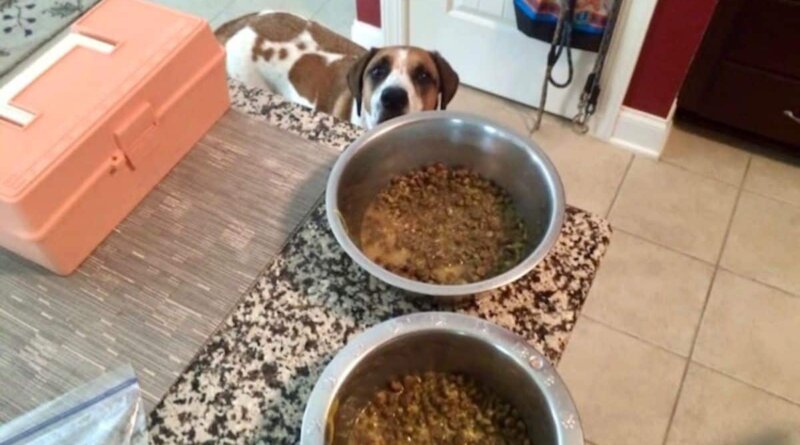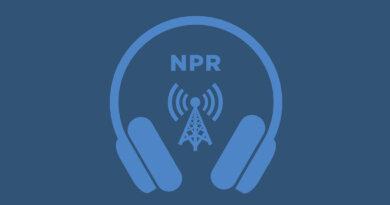Should I Add Water To My Dog’s Dry Food?
This post may contain affiliate links. We may earn money or products from the companies mentioned in this post.
Should I add water to my dog’s dry food?
Our guide dog school has recently advised us to add a small amount of water to our dog’s kibble.
Basically, just enough water to make your dog’s kibble like bobbing for apples.
Pet sitting client Molly waiting for her kibble to soak
Outside of guide dog puppies, should you add water to your dog’s food?
If you feed kibble, you’re probably seen the reminder to always provide your dog with fresh water on any given bag that you’ve purchased.
After all, the reason that dry dog food has its name is that the average moisture content of kibble is only somewhere between 6% to 12%!
That’s a fraction of the moisture content you’ll find in canned and raw dog food, which is between 75%-85%.
It makes sense when you think about it from a shelf life perspective as moist food spoils more quickly than dry food.
But we all know that proper hydration is essential for proper organ functioning and good health in all living beings, so what about adding water to your dog’s dry food?
That’s a valid question, especially if your pup doesn’t drink enough water from their bowl!
So in this blog post, we’ll look at 8 pros and 3 cons of putting water in kibble.
We’ll also provide different soaking time guidelines to achieve a variety of purposes and mention the ratio of water to dry food to add.
Last but not least, we’ll talk about whether or not soaked kibble has an impact on bloat along with 9 moisture rich food toppers as an alternative to water.
Ready? Let’s jump right in!
What Is The Benefit Of Adding Water To Dog Food?
Below, you’ll find 8 reasons why adding water to a dog’s dry food can be beneficial.
Improved Hydration
The most obvious benefit is that adding water to dry dog food helps increase the moisture content of the meal.
This is particularly beneficial for dogs who:
- Are diagnosed with certain diseases like kidney disease, diabetes and UTIs
- Don’t drink enough water on their own
For example, dogs with kidney disease often experience increased water loss because they have to pee excessively.
That’s why soaked kibble can help support kidney function and prevent dehydration.
For dogs with diabetes, they typically have increased water consumption due to high blood sugar levels. That’s why it can be helpful to add water to kibble to manage their condition and prevent dehydration.
Also, UTIs can cause increased thirst and urination in dogs. That’s why hydrated kibble can help these pups flush out bacteria and maintain urinary tract health.
Help With Dental Issues
Older dogs with dental problems, missing teeth, or sensitive gums may have difficulty chewing and swallowing dry kibble.
That’s when adding water can be really helpful because it softens the food and makes it easier for them to eat and digest.
I remember doing this with my dog Buzz after he had a tooth removed at his vet’s.
He was 4 years old at the time and had fractured one of his upper molars when he was chewing on a smoked beef bone from the grocery store.
So I soaked his kibble in water for 5 minutes while he had a swollen cheek, which lasted for 2 weeks.
Since he was always a picky eater while he ate kibble, I also added a few moisture-rich food toppings he enjoys from the list in an upcoming section.
Just FYI, this incident happened a few months before I switched Buzz and his sister Missy from kibble to raw dog food, and I learned 3 valuable lessons when I did:
- Raw-fed dogs drink a lot less water than kibble-fed dogs because as I mentioned before, raw dog food has almost 8 times more water content than kibble.
- You should never offer your dog weight bearing bones from large hooved animals such as cows. That’s because they’re incredibly dense and hard given the amount of animal weight they have to support! And yes, it’s enough to break a dog tooth.
- Raw dog food offers lots of food variety and different textures that can “cure” a picky eater. Buzz stopped his food antics the moment he started eating raw dog food, and I never had to entice him to eat ever again.
Enhanced Palatability
Some dogs may find dry kibble less appealing due to its texture or taste.
That’s particularly true for smaller dog breeds who are known to be picky eaters anyways.
In this case, adding water can not only make the food softer, it also brings out more of its flavor, especially when the water is lukewarm.
I remember having to do this for several of my smaller pet sitting clients!
Digestive Aid
Moistening dry dog food can also help with a dog’s digestion, especially in dogs with sensitive stomachs or those prone to gastrointestinal issues.
The added moisture helps break down the food more easily, facilitating digestion and nutrient absorption.
In some cases, it can also help alleviate constipation or dry stools.
Weight Management
Adding water to dry dog food increases the volume of the meal without increasing the calorie content.
That way, it gives them a larger portion size that helps them feel fuller although you’re feeding them less kibble.
So this approach can be beneficial for kibble-fed dogs on a weight management program.
Temperature Regulation
For dogs who live in hot climates, adding water to dry dog food can help keep your dog cool and hydrated, especially if they don’t drink enough water on their own.
That way, it provides an additional source of water intake and helps prevent overheating.
Enhanced Nutrient Absorption
Moistening dry dog food can also assist in the absorption of nutrients from the meal.
The water helps to break down the food particles and makes it easier for the dog’s body to extract and utilize the nutrients from the food.
Obviously, this can contribute to improved overall health and vitality in your dog.
Customization for Individual Needs
Adding water to dry dog food also makes it easier to customize your dog’s meal based on their specific needs.
For example, if your dog requires additional joint support, you can mix in their supplements with the water before moistening the dry food.
This way, you can tailor the meal to address specific health concerns or dietary requirements.
Potential Cons Of Putting Water In Kibble
OK, now that we’ve looked at several different benefits, let’s cover a few downsides of soaking kibble in water.
Spoilage
The most important downside is that wet kibble can spoil if it’s not eaten within a reasonable timeframe.
As a general guideline, moistened kibble should not be left out at room temperature for more than 2 hours, so soaking kibble may not work well for dogs who graze.
After that time, bacteria can start to multiply rapidly, increasing the risk of foodborne illnesses or spoilage.
That’s why it’s important to throw out any uneaten food promptly to avoid bacterial growth or contamination.
Texture and Palatability
Some dogs may prefer the texture and taste of dry kibble and may not enjoy it once it’s moistened.
So go ahead and observe your dog’s preference and adjust the soaking time or water amount accordingly.
Portability and Convenience
Soaking kibble may not be as convenient for travel or on-the-go situations compared to dry kibble, especially if your dog prefers really mushy dry food, which takes a while to get to its consistency.
How Long To Soak Kibble In Water?
We haven’t talked about how long you should soak kibble for, so let’s do that now.
And just as a side note, as far as what dry dog food you can add water to, you can add water to any brand or type of dry dog food.
But do yourself and your pup a favor and try to avoid these 10 worst dry dog foods!
Keeping that in mind, how long to soak kibble in water depends on the specific needs of your dog.
Here are some time guidelines for soaking kibble:
- 5-10 minutes: Makes it easier for dogs with dental issues to chew dry dog food without turning it into a complete mush.
- 10-15 minutes: Helps release more of the food’s aroma and can make it more appealing for picky eaters (especially if you use warm water).
- 20-30 minutes: Long enough for the kibble to completely absorb the water. This considerably increases your dog’s hydration level.
How Much Water To Add To Dry Dog Food?
When you’re adding water to dry dog food, you’ll need to find the right balance to meet your pup’s respective needs.
A good starting point is to add ¼ cup of water per 1 cup of dry dog food.
Observe how your dog reacts to their moistened food. Some dogs prefer a softer texture, while others may prefer it only slightly moistened.
Gradually adjust the amount of water based on your dog’s preference.
For most dogs (except those with dental issues), the goal is to moisten the kibble without turning it into a mushy consistency.
Because the problem with mushy kibble is that it can stick to your dog’s teeth and cause buildup if you don’t brush them.
So ideally, the food should be softened and easier to chew, but still retain some texture.
Can Adding Water To Dry Dog Food Cause Bloat?
Thankfully, adding water to dry dog food generally does not cause bloat.
If you don’t know what bloat is, it’s also known as gastric dilatation-volvulus (GDV).
That’s a serious and potentially life-threatening condition when a dog’s stomach fills with gas, twists on itself and cuts off the dog’s oxygen supply.
That said, bloat is more commonly associated with:
- Rapid eating
- Large meals
- Consuming large amounts of water in one sitting
- Exercising vigorously shortly after eating
Which makes the most important factors in preventing bloat:
- Feeding smaller, more frequent meals
- Using dog slow-feeders or puzzle toys to slow down eating
- Avoiding exercise for 30-60 minutes before and after meals
- Being mindful of the dog’s individual risk factors (certain deep-chested breeds are predisposed to bloat)
Pet sitting client Truman with his slow feeder dog bowl
On that note, one of my pet sitting clients was a Great Dane owner who was acutely aware of the fact that her favorite dog breed was also the most prone to bloating.
She had decades of experience with Great Danes, and she always instructed me to add a little warm water to their kibble meals when I fed them.
My Great Dane clients Shade, Haley & Shaun with their moistened kibble
What Else Can I Add To My Dog’s Dry Food For Moisture?
Besides pure water, you can also top your dog’s dry food off with certain foods that are naturally rich in water!
For example:
- Cucumber (95% water content)
- Watermelon (90-92% water content)
- Pumpkin purée (90-92% water content)
- Bone broth (90-95% water content)
- Green beans (90% water content)
- Goat’s milk (85-90% water content)
- Plain kefir (85-90% water content)
- Plain yogurt (75-85% water content)
- A raw egg (75-80% water content)
Pet sitting client Oakley had her kibble topped off with green beans for extra moisture
These foods may be a better option for extremely picky eaters who demand more flavor than just plain water!
They’re also packed with a variety of essential nutrients such as Vitamins and minerals, so what’s not to love?
Note: While all of these options can contribute to hydration due to their water content, they should not replace your dog’s regular water intake.
You can also top your dog’s dry food off with some canned dog food or raw dog food. Both are considerably richer in water than kibbles.
Bottom Line
The moisture content of dry dog food is relatively low compared to the moisture content in canned and raw dog food.
This is why adding water to dry dog food can be particularly useful for dogs that:
- Are older
- Are picky eaters
- Live in a hot climate
- Don’t drink enough water
- Have increased hydration needs due to illnesses
- Have difficulty chewing dry kibble because of dental issues
When you’re gauging the right amount of water to add your dog’s dry food, start with ¼ cup of water per cup of kibble, and work your way up from there.
However, please remember that soaked kibble can spoil relatively quickly, so you’ll want to pick up any uneaten soaked food after 2 hours and toss it.
Besides water, you can also add some extra hydration with foods that are naturally rich in water such as watermelon, cucumber and pumpkin purée.
Save To Pinterest
Top Picks For Our Puppies
- BEST PUPPY TOY
We Like: Calmeroos Puppy Toy w/ Heartbeat and Heat Packs – Perfect for new puppies. Helps ease anxiety in their new home. - BEST DOG CHEW
We Like: Mighty Paw Naturals Bully Sticks – All of our puppies love to bite, nip, and chew. We love using Bully Sticks to help divert these unwanted behaviors. - BEST DOG TREATS
We Like: Crazy Dog Train-Me Treats – We use these as our high-value treats for our guide dog puppies. - BEST FRESH DOG FOOD
We Like: The Farmer’s Dog – A couple months ago we started feeding Raven fresh dog food and she loves it! Get 50% off your first order of The Farmer’s Dog.
Check out more of our favorites on our New Puppy Checklist.




